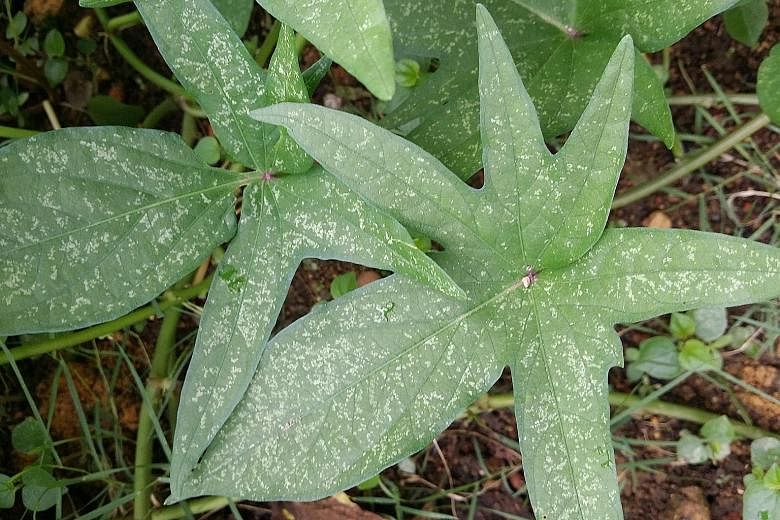Mexican Sunflower's anti-diabetic effects tested only on animals
Is this the insulin plant (pictured)? Does it have medicinal properties and what can it be used for?
Catherine Loy
This plant is commonly known as the Mexican Sunflower and botanically called Tithonia diversifolia.
It is a tall, shrub-like plant that thrives under direct sunlight and needs well-drained, fertile soil. It is often grown along the edge of ponds and lakes.

A study had demonstrated its anti-diabetic effects, but it was conducted on laboratory animals. More work needs to be done to see if this plant is safe and has the same effect on humans.
Do not self-medicate with plants without professional guidance.
Lace bugs cause black spots on leaves
The leaves of my spearmint dried up and have black spots at the top (pictured).
Some leaves also curled up. What should I do?
Khor Kok Wah
Your plant appears to be infested with lace bugs - the small, slow- moving black insects on the leaves.
They suck sap from the foliage, which causes it to become spotted. In severe cases, the leaf dies.
These pests are not easy to manage. Large populations can be reduced by pruning heavily infested parts of the plant.
As the spearmint is edible, you may want to use neem oil or summer oil to suffocate and kill the insects.
Repeated applications are necessary to cull the population.
Lace bugs affect herbs such as basil and rosemary, which are from the same plant family. You may need to practise crop rotation.
Do not grow these plants for several months to remove the lace bugs' food source. This will help reduce their population
Use neem oil or summer oil to control leafhoppers
There are white spots (pictured) on the leaves of the sweet potato plant growing in my garden.
What causes them and are the leaves safe to eat? How can I get rid of the spots?
Kee Ang
The spots are likely caused by a type of sap-sucking insect, such as the leafhopper. The leaves can still be consumed.
However, leafhoppers can be difficult to eliminate. For edible plants, you may want to use neem oil and summer oil to suffocate and kill the insects. Repeated applications are necessary to cull the population.

Periwinkle affected by fungal disease
I removed leaves on my periwinkle that had brown spots (left).
But the spots keep appearing on others.
The flowers also drop easily when I rummage through the leaves.
I water the plant daily and sprinkle some water on the leaves.
I added fertiliser once.
What is wrong with the plant?
Also, what is this plant with purple flowers (left) and how do I care for it?
Julie Lim
Your periwinkle appears to be affected by a fungal disease - a common problem with most cultivated periwinkle hybrids.
You should remove the infected leaves.
To prevent this from happening again or to reduce the severity of the disease, grow the plant in a sunny spot with ample air circulation.
Keep it away from heavy rain and under shelter during the rainy season.
You can apply Captan, a foliar fungicide.
The plant with purple flowers is the Wishbone Flower and its botanical name is Torenia fournieri.

There are several cultivars that come in different floral colours such as yellow, pink and light blue.
The Wishbone Flower needs a sunny spot and moist, well-drained soil to thrive. It may also produce seeds, so it will not be unusual to see small plants popping up in your garden.
Tip: Gold Vein Plant's attractive foliage is great in an outdoor garden
The Gold Vein Plant (pictured), botanically known as Sanchezia nobilis, is grown mainly for its ornamental, colourful foliage.
Its network of prominent gold veins on the leaves contrast against the green background.
To get this attractive foliage, grow the shrub under full sun in moist and well-draining soil.
It can be a hedge or a specimen plant in an outdoor garden. Prune it for a compact and bushy look. The plant can be easily propagated via stem-cuttings.
•Answers by Dr Wilson Wong, a certified practising horticulturist and founder of Green Culture Singapore (www.greenculturesg.com). He is also an NParks-certified park manager.
•Have a gardening query? E-mail it with clear, high-resolution pictures of at least 1MB, if any, and your full name to stlife@sph.com.sg.




